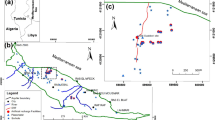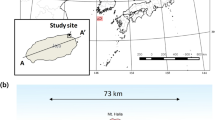Abstract
The Nile Delta aquifer in Egypt is one of the largest groundwater reservoirs worldwide. It contributes significantly to the water budget of the country and acts as the main source of freshwater apart from the Nile River. Due to excessive pumping to meet the increasing water demands, the seawater intrusion from the Mediterranean Sea has been triggered affecting the groundwater quality in the northern and middle zones of the Nile Delta aquifer. This paper investigates the possible adverse impact of reducing the flow in the Nile River due to the construction of the Grand Ethiopian Renaissance Dam on the Nile Delta aquifer and considers possible measures to adapt with such impacts. A numerical model is developed using SEAWAT to simulate the groundwater flow and solute transport considering the operation of the new dam. Two scenarios of filling the reservoir during 3 and 6 years were considered. The maximum groundwater drawdown in the middle Delta will reach 2.65 m under the conditions of scenario one and 1.4 m under the conditions of scenario two. Equi-concentration lines 1000 and 35,000 ppm would advance to a distance of 110.2 and 70.85 km, respectively, under the first scenario and 108.25 and 67.3 km, respectively, under the second scenario. Results indicated that filling the reservoir in 3 and 6 years would require reducing groundwater abstraction rates from the Nile Delta aquifer by 60 and 40%, respectively, to maintain the freshwater body in the Nile Delta aquifer.







Similar content being viewed by others
References
Abd-Elaty IM, Abd-Elhamid HF, Fahmy MR, Abdelaal GM (2014a) Investigation of some potential parameters and its impacts on saltwater intrusion in Nile Delta Aquifer. J Eng Sci Assiut Univ Fac Eng 42(4):931–955
Abd-Elaty IM, Abd-Elhamid HF, Fahmy MR, Abdelaal GM (2014b) Study of impact climate change and other on groundwater system in Nile Delta Aquifer, the Egyptian. J Eng Sci Technol Zagazig Univ Fac Eng 17(4):2061–2079
Abdelkader TA, Elsanabary MH (2015) Hydrological and environmental impacts of grand ethiopian renaissance dam on the Nile river. In: Eighteenth international water technology conference, IWTC18 Sharm ElSheikh, Egypt
Amer A, Sherif MM (1996) An integrated study for seawater intrusion in the Nile Delta Aquifer, working paper for SRP, NWRC-MPWWR, and Cairo, Egypt
Armanuos AM, Ibrahim MG, Mahmod WE, Negm AM, Yoshimura C, Takemura J, Zidan BA (2017) Evaluation of the potential impact of Grand Ethiopian Renaissance Dam and pumping scenarios on groundwater level in the Nile Delta aquifer. Water Sci Technol Water Supply 17(5):1356–1367. https://doi.org/10.2166/ws.2017.037
Ball J (1939) Contribution to the Geology of Egypt. Survey and Mines Department, Cairo, pp 1–308
El-Atfy H (2007) Integrated National Water Resources Plan in Egypt, Ministry of Water Resources and Irrigation Alexandria Governorate
El-Fayoumy IF (1968) Geology of groundwater supplies in the eastern region of the Nile Delta and its Extension in North Sinai, Ph.D. thesis, Faculty of Science, Cairo University, Egypt, pp 1–207
Hefny KH (1980) Groundwater in the Nile Valley, Ministry of Irrigation. Water Research Center. Groundwater Research Institute, pp 1–120 (in Arabic)
Langevin CD, Shoemaker WB, Guo W (2003) MODFLOW-(2000), the U.S. geological survey modular ground-water model—documentation of the SEAWAT-2000 version with the variable-density flow process (VDF) and the integrated MT3DMS transport process (IMT): U.S. Geological Survey Open-File Report 03-426
Langevin CD, Thorne Jr. DT, Dausman AM, Sukop MC, Guo W (2008) SEAWAT Version 4: a computer program for simulation of multi-species solute and heat transport. Techniques and methods book 6, chapter A22. U.S. Department of the Interior, U.S. Geological Survey
Morsy WS (2009) Environmental management to groundwater resources for Nile Delta Region, Ph.D. thesis, Faculty of Engineering, Cairo University, Egypt
Moussa A, Soliman M, Aziz M (2001) Environmental Evaluation for High Aswan Dam since its Construction until Present. In: Sixth international water technology conference, IWTC 2001. Alexandria, Egypt
Negm AM, Ramadan EM, Helmy AE, Sammany M (2014) Quantifying the impacts of impounding grand Ethiopian renaissance dam reservoir on Nasser Lake active storage. In: 2nd international conference on oceanography, July 21–23, 2014 Hampton Inn Tropicana, Las Vegas
Nossair AM (2011) Climate changes and their impacts on groundwater occurrence in the Northern part of East Nile Delta, M.Sc. thesis, Faculty of Science, Zagazig University, Egypt
RIGW (2002) Nile Delta Groundwater Modeling Report. Research Institute for Groundwater, Kanater El-Khairia
RIGW (Research Institute for Groundwater) (1980) Projected of the Safe Yield Study for Groundwater Aquifer in the Nile Delta and Upper Egypt, Part1. Ministry of Irrigation, Academy of Scientific Research and Technology, and Organization of atomic Energy, Egypt (in Arabic)
RIGW (Research Institute for Groundwater) (1992) Hydrogeological map of Nile Delta, Scale 1: 500,000, 1st edn. RIGW, Nile Delta
Rizzini A, Vezzani F, Coccetta V, Milad G (1978) Stratigraphy and sedimentation of a Neogene: quaternary section in the Nile Delta Area. Mar Geol 27:327–348
Roger LJ, Kazuro M, Kei N (2009) Effects of artificial recharge and physical barrier on seawater intrusion. Ann J Hydraul Eng JSCE 53:55
Said R (1981) The geological evaluation of the River Nile. Springer, New York
Sallouma MKM (1983) Hydrogeological and hydrochemical studies East of Nile Delta, Egypt. Ph.D. thesis, Faculty of Science, Ain Shams University
Serag El Din HM (1989) Geological, hydrochemical and hydrological studies on the Nile Delta Quaternary Aquifer. Ph.D. thesis, Faculty of Science Mansoura University, Egypt
Sherif MM, Singh VP (1997) Groundwater development and sustainability in the Nile Delta Aquifer. Final Report Submitted to Binational Fulbright Commission, Egypt
Sherif MM, Singh VP (2002) Effect of groundwater pumping on seawater intrusion in coastal aquifers. J Agric Sci 7(2):61–67
Sherif MM, Singh VP, Amer AM (1988) A two dimensional finite element model for dispersion (2D-FED) in Coastal Aquifers. Hydrol J 103:11–36
Sherif MM, Sefelnasr A, Javadi A (2012) Incorporating the concept of equivalent freshwater head in successive horizontal simulations of seawater intrusion in the Nile Delta Aquifer. J Hydrol, Egypt. https://doi.org/10.1016/j.jhydrol.2012.07.007
SNC (2010) Egypt’s Second National Communication, Egyptian Environmental Affairs Agency (EEAA-May 2010), under the United Nations Framework Convention on Climate Change on Climate Change
Tesfa BC (2013) Benefit of grand Ethiopian Renaissance Dam Project (GERDP) for Sudan and Egypt. J Energy Water Environ Econ 1:1–12
Whittington D, Waterbury J, Jeulandc M (2014) The grand renaissance dam and prospects for cooperation on the Eastern Nile, Water Policy Uncorrected Proof, pp 1–14
WMRI-NWRC (2002) Unpublished Report under the Matching Supply and Demand Project, Water Management Research Institute, National Water Research Center, Ministry of Water Resources and Irrigation, Egypt
Acknowledgements
The authors are grateful to the Department of Water and Water Structures Engineering, Faculty of Engineering, Zagazig University, Egypt, for supporting this research through a fully funded Ph.D. study.
Author information
Authors and Affiliations
Corresponding author
Additional information
Editorial responsibility: M. Abbaspour.
Rights and permissions
About this article
Cite this article
Abd-Elhamid, H., Abdelaty, I. & Sherif, M. Evaluation of potential impact of Grand Ethiopian Renaissance Dam on Seawater Intrusion in the Nile Delta Aquifer. Int. J. Environ. Sci. Technol. 16, 2321–2332 (2019). https://doi.org/10.1007/s13762-018-1851-3
Received:
Revised:
Accepted:
Published:
Issue Date:
DOI: https://doi.org/10.1007/s13762-018-1851-3




